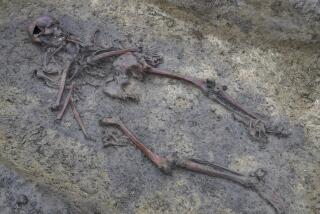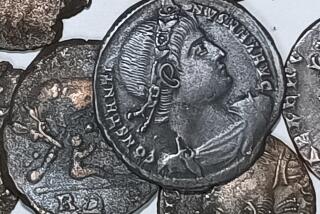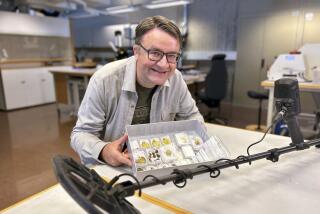Viking hoard found in northern Britain
- Share via
LONDON — One of the biggest Viking treasures ever found has been discovered on an English farm by a father-son team of amateur treasure hunters, the British Museum announced Thursday.
The trove of coins and jewelry, buried more than 1,000 years ago, contains items from Ireland, France, Russia, Scandinavia and Afghanistan, testifying to the raiders’ international reach.
“It’s a fascinating find; it’s the largest find of its type of over 150 years” in Britain, said Gareth Williams, an expert at the British Museum.
In 1840, workers in Lancashire discovered the so-called Cuerdale Hoard -- a mass of 8,500 silver ingots, coins, chains, and amulets.
The latest find came in northern England, where David Whelan, 60, and his 35-year-old son, Andrew, were trawling a through a farmer’s field near Harrogate on Jan. 6 when their metal detectors squealed. The pair began digging, finding a silver bowl more than a foot beneath the surface. Under British law, such finds must be reported to authorities. A court declared the find to be treasure, entitling the Whelans and the landowner to split the proceeds.
The pair turned the bowl over to archeologists, who discovered it was packed with coins and jewelry. The bowl, a 9th century gilt silver container probably seized by Vikings from a monastery, had been used as an improvised treasure chest.
In all, more than 600 coins and dozens of other objects, including a gold armband and silver ingots, were found in and around the container.
Some of the coins mixed Christian and pagan imagery, shedding light on the beliefs of newly Christianized Vikings, said Williams, of the British Museum.
The booty probably was accumulated through a mix of commerce and warfare, he said. Its quantity indicated that at least some of it was taken by force, perhaps in raids in northern Europe or Scandinavia.
The Museum said the loot was hidden sometime after the fall of the Viking Kingdom of Northumbria in 927. Vikings often buried their wealth in times of trouble.
The museum said it hoped to buy at least some of the hoard from the Whelan family.
“We thought it was marvelous,” David Whelan said. “But we didn’t know for nearly a month what was in it.”
More to Read
Sign up for Essential California
The most important California stories and recommendations in your inbox every morning.
You may occasionally receive promotional content from the Los Angeles Times.













